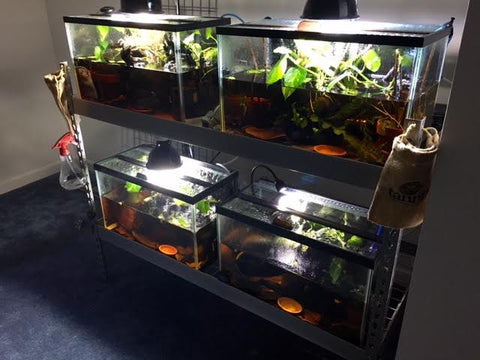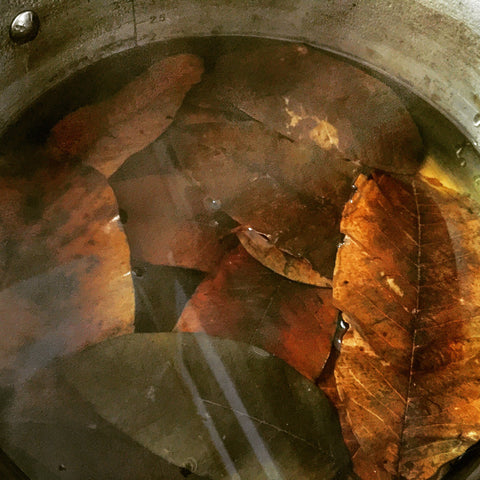- Continue Shopping
- Your Cart is Empty
Shining light into the dark waters...new questions in search of new answers...
As we've progressed in this whole botanical/blackwater "genre", I know I have personally learned a ton about the setup, husbandry and long-term maintenance of these systems. It's been amazing so far, and I'm proud that the Tannin community has been on the forefront of this "movement" in the hobby!
Although hobbyists have kept blackwater tank for years, I think it's only been quite recently that they have literally "emerged from the darkness" and have become a more popular, accessible subject for experimentation and enjoyment among fish geeks!

It seems like almost every day we are hearing from hobbyists who have started a blackwater tank, and have made some interesting observation that can give us insights into the "best practices" surrounding the application of botanicals for blackwater tanks.

And of course, with new people and new task comes new ideas; new approaches- and a refinement of techniques already "in play." And this is really great, because it makes the whole "mystery aspect" of keeping botanical/blackwater tanks that less "mysterious."

There are so many areas that almost anyone getting in the game can contribute to. Here are just a few of the things that I know I'm going to be looking into over the coming months:
*Really locking down which leaves seem to be most effective at reducing pH in a given sized sample of RO/DI water, and seeing if there is a way to at least come up wit ha more reliable "baseline" for how many leaves to use "per gallon", if we start with specific source water conditions...And of course, I'd do the same for preparing water to use in changes as well, rather than just the "4 Nano Catappa leaves in a 5 gallon container" approach I use now...
*I'm curious how effective the once-dreaded biofilms are as a supplementary food source for small fry of a variety of fishes. In other words, for certain fishes, would it make sense to create a more natural "rearing tank" incorporating a leaf litter bed?
*Is there a pH "equilibrium point" where a tank maintains a very steady pH based on the amount of botanical material present? IS there even a way to determine this?

*Is the "tea" created when I prepare botanicals truly something I should be discarding? I have always done this, for fear of adding pollutants and contaminants released during boiling, but a growing number of hobbyists tell me they always use this stuff as an "additive", and that it's kind of a waste to discard it...That's a tough experiment for me to undertake, but I may have to let go of my fears at some point in the interest of knowledge acquisition!
*How deep a leaf litter bed can you keep in an aquarium? What types of flow and filtration requirements would be optimal with a very deep (like 8"-10" 20-25cm) bed? In nature, leaf litter beds can be several feet deep! Is there a maximum practical limit for aquaria? What are the challenges associated with the management of a deep leaf litter system? Are there techniques to limit any deleterious effects? Are there any bad things that can happen? What are they? How much flow can you push through it without displacing the material? Might be time to break out the old Vortec pumps from my reefing days!

*How well do aquatic plants do in a blackwater tank over the long haul? Can they keep growing steadily? Is there a "barrier" point where they reach their max potential, or is this just aquarium theory?
And finally, the ongoing "experiment":
Leaf litter tanks over the intermediate long term (like a year and a half or so) have shown surprising stability when I've adhered to some regular maintenance and "replenishing" practices. My hypothesis is that you can keep one of these types of tanks running almost indefinitely with the practices I've embraced. I want to see if this holds out, and what the challenges are (if any) to keeping one of these tanks going for several years.
These are just a few of the dozens of things I'd like to tackle in the near future. I know a bunch of you have set up your own experiments. This is so important; so helpful for advancing the "state of the art" that we have developed in this formerly obscure specialty niche in the amazing aquarium hobby!

Experimenting, discussing, and sharing are so easy to do in the wonderful time in which we live. It's truly "open source", and everyone's effort counts!

What ideas are YOU working on? What discoveries will you make?
We can't wait to hear and see them!
Be experimental. Stay open minded. Stay observant. Stay excited.
And stay wet!
Scott Fellman
Tannin Aquatics












Scott Fellman
Author